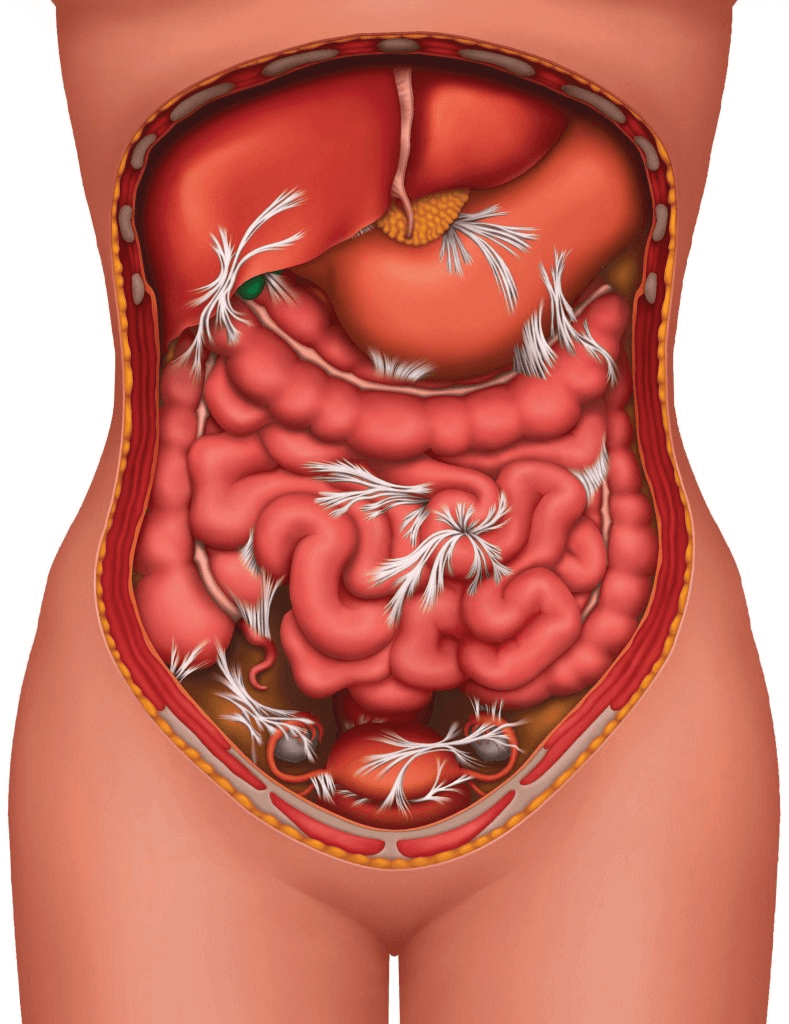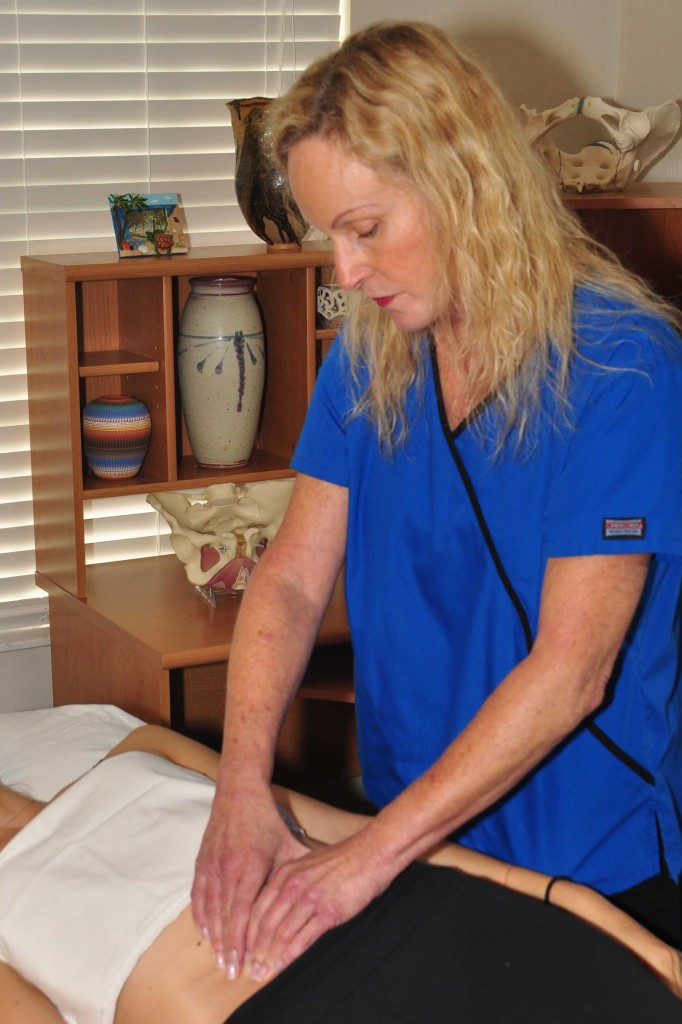Testimonials of Clear Passage patients receiving therapy taking care of pelvic adhesions.
We Decrease or Eliminate Adhesions Without Surgery
Overview
Adhesions, the internal scars that tend to form whenever the body heals, are a major problem for patients and their physicians.
While these internal scars initially formed to help the body heal from tissue damage, adhesions tend to remain long after the initial tissue damage has passed. Once formed, adhesions can remain like a straitjacket around delicate organs, squeezing them tightly or binding them to one another. When this occurs, the delicate organs of the abdomen and pelvis can lose their normal function. Having lost the flexibility to expand and contract normally, these organs and the associated nerves become bound by a glue-like structure, often causing pain.
Adhesions tend to attach to digestive, reproductive, and endocrine organs throughout the abdomen and pelvis. When this happens, they can act like glue, binding those structures in straitjacket like bonds, estimated at 2,000 pounds per square inch (140 kilos per square centimeter.) When adhesions wrap around nerves, they can cause pain. Adhesions at muscles decrease normal mobility. When they form at an organ or gland, they can decrease the function of that organ, whether it is reproductive, digestive or endocrine.
Adhesions are largely composed of collagen, a substance that surrounds virtually every structural cell in the body. Thus, most adhesions do not generally appear on diagnostic tests such as MRI, CT scan or ultrasound. When the patients go to the doctor to learn what is wrong, their physician may tell them “I don’t see a problem,” or “there’s nothing there” – or worse “I think it’s all in your head.” Meanwhile, the patient is suffering from powerful internal bonds called adhesions that your doctor cannot see.
Adhesions can be strong enough to cause significant pain. People who suffer from adhesions may complain of “unexplained pain” in one or more parts of their body. Some patients even tell us “It feels like I have straitjackets inside me.” Others say to “I have an internal pulling sensation.”
Since their doctor cannot see the adhesions on diagnostic tests, the patient may be referred from specialist to specialist, looking for relief from their symptoms. Thus, adhesion pain can often be a source of significant frustration and mild to debilitating pain.
Causes and Frequencies of Adhesions
Adhesions that form in the abdomen and pelvis are often caused by surgery; other common causes include trauma (accidents), infection and endometriosis or peritonitis. When tissue trauma occurs, the membrane covering the abdominal and pelvic organs becomes inflamed. Next, the inflammation or infection can spread throughout the interstitial spaces of the abdominopelvic cavity – the spaces between organs, muscles, glands and support structures. Frequent causes of peritonitis in our patients include burst appendix, ruptured cysts, infection or leakage of bowel contents into the abdomen following surgery.
Adhesions form when thousands of tiny strands of collagen, like the strands of a nylon rope, come rushing in to cover and isolate injured tissue. These strands attach to each other with a molecular, chemical bond. Type 2 adhesions have a tensile strength that is stronger than steel. It has been estimated at 2,000 pounds per square inch (140 kilo grams per square centimeter). When these tiny but powerful bonds form in the abdomen or pelvis, they tend to pull the trunk of the body forward in space. Trying to remain upright to see your computer screen or see where you are going, your back and neck muscles struggle valiantly to keep you up straight against the powerful pull of these adhesions. Thus, as well as the pain or discomfort at the abdomen and pelvis, patients with abdominopelvic adhesions tend to develop pain at their back, neck and sometimes cranium, often with headaches, especially at the temple or base of the skull.
Treatment Options
Experience life-changing relief from debilitating abdominal and pelvic adhesions with Clear Passage Physical Therapy’s Free Consult and Request Info – discover their unique, non-surgical approach that has successfully treated hundreds of patients, potentially saving you from risky surgeries and giving you back the pain-free life you deserve. To learn more visit our Apply to Therapy page.
While the patient may have an excellent sense of where the problem lies, their physician literally cannot see adhesions unless they do another surgery. Unfortunately, surgery is a primary cause of abdominopelvic adhesions. Adhesions create a major dilemma in modern medicine, as the surgery to decrease adhesions frequently causes new adhesions to form. Some doctors and patients note that “the cure can be as bad as or worse than the disease.”
Clear Passage®️ Therapy
Our therapists are experts in adhesion formation – and deformation. Since 1988, our focus has been to decrease and eliminate adhesions without surgery or drugs. If you choose to come to therapy, we will work to decrease and eliminate the internal bonds that are causing your problems. Our goal is to return you to a life where your organs, muscles and nerves are free of these internal bonds.
The work we have developed over the last 30+ years addresses these adhesions at the source. Using manual therapy, our focus is to dissolve the chemical bonds that attach each collagen’s strand to its neighboring strands. Over the course of 20 hours of decreasing adhesions, we tend to restore our patients’ health to what it was before these adhesions formed.
Clear Passage®️ is a ‘gold-standard’ in the non-surgical treatment of adhesions. It is the only therapy with published studies in peer-reviewed medical journals showing success rates treating abdominal and pelvic adhesions. We encourage you to talk to us before you undergo another surgery – a procedure that may help you in the short term, but statistically is likely to create additional adhesions and additional problems for you in the future.
Over the last 25 years, our therapists have dedicated much of their professional careers to decreasing and eliminating adhesions, non-surgically. Our network of clinics has treated hundreds of patients who came to us with adhesions that formed after an injury, trauma or infection. Most complained of significant, often unexplained pain. While adhesion pain can occur anywhere (neck, back, hip, etc.) our patients often report unexplained pain and tightness in the abdomen and pelvis. The pain can be constant or intermittent, and may increase with certain movements or activities such as bowel movements, sexual intercourse or diet changes.
Results for these patients are generally very good to excellent after therapy; many of the patients we treated for adhesion-related disorders tell us “You gave me back my life.” We believe therapy is generally successful for two reasons:
- It pulls apart adhesions non-surgically, like pulling apart the run in a three-dimensional sweater or pulling out the strands of a nylon rope.
- Unlike surgery, this therapy does not appear to create new adhesions, which is a major advantage for our patients.
Other Medical Treatments (Surgery, Drugs)
- Surgery
- Unfortunately, medical studies show that surgery in these areas generally causes more adhesions to form. In a 50+ year study of thousands of abdominal and pelvic surgeries in the Western world, surgery was found to create new adhesions in 55% to 100% of cases. Unfortunately, no matter how skilled the surgeon, the body needs to heal from the surgery. In doing so, it lays down adhesions as the first step in healing.
- Pain Medication
- Since physicians are unable to find the root cause of your problem through diagnostic tests, they are unable to make a clear plan of action to treat your pain. Thus, they may prescribe pain medication to ease your symptoms, without fixing them.
Published Success Rates
We have been able to monitor and publish results in respected peer-reviewed medical journals, including ‘before and after’ x-ray films showing the structural changes we achieve for patients with conditions caused by abdominal and pelvic adhesions.
Testing results with pelvic adhesions. Several studies showed that the therapy opened totally blocked fallopian tubes. Because these tiny structures generally block from adhesions, a review of dye tests conducted before and after therapy provides a good indication of success. In our largest such study, we opened fallopian tubes in 69% of patients — 180 women who had never had surgery on their fallopian tubes. When we included women who had undergone prior surgery to these tiny structures, we opened tubes in 61% of 235 patients.
Testing results with abdominal adhesions. One of the more serious, life-threatening conditions that forms from adhesions is small bowel obstruction. Published studies of our work, with before and after radiographic films, demonstrated that we cleared adhesive bowel obstructions – a life-threatening condition. Studies showed that the obstructions cleared, whether the bowel was kinked from the outside like a garden hose or constricted by an internal stricture – the hourglass shaped narrowing of the bowel. Note: While radiographs cannot show adhesions, they can show their effect. Thus, physicians were able to use radiopaque dye to determine these results for clearing blocked fallopian tubes and blocked intestines.
To view a full list of Clear Passage®️ success in treating adhesion-related disorders, please visit our Published Success Rates page.
Testimonials
To read past patient success stories, please visit our Testimonial page.
Related Content:
- Adhesions and Scar Tissue
- Abdominal / Pelvic Adhesions
- Fascia and Fascial Adhesions
- What You Need to Know About Pelvic Adhesions
- Do Abdominal Adhesions Show on an MRI Scan?
- Patient Story: No Longer Shackled by Adhesions
- 3 Ways Adhesions Cause Bowel Obstructions
- How to Prevent Surgery Adhesions
- Adhesions in the Body: Presentation by Larry Wurn (Video)
- Break the Adhesion-Surgery Cycle
- Lifesaving Therapy for Intestinal Obstructions Comes to St. Louis
- Pelvic Adhesions: What You May Not Know
- What Are Adhesions? (Infographic)
- Adhesions: What You Can’t See Can Hurt You
- How Can Therapy Help Adhesions


























